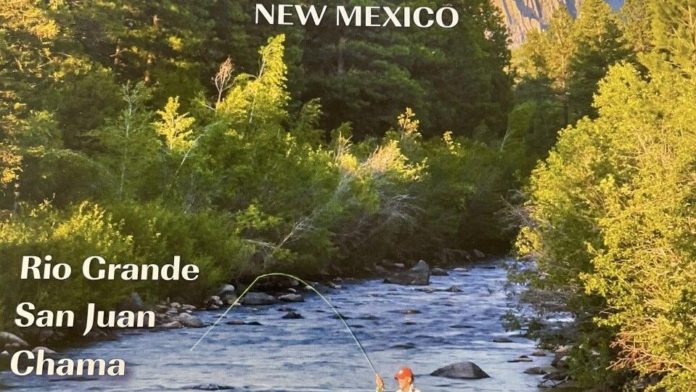Ideas about where to fish are often the result of a fishing report — either by the media or from friends. But that fish has already been caught. Better to call a fly shop and ask what they think is about to happen. Or check out how a commercial fly angler (a guide) goes about this very important aspect of the game.
Our trusty guide is up before breakfast, sticks her finger out the window, and tests the air. Is it hot, cold, cloudy, or clear? Windy, raining, or even snowing (a great fishing condition)? This all goes into the equation. Then it’s to the iPhone or TV for the weather forecast, and finally, she Googles “New Mexico stream flows.” Calls to other guides and good fishermen are made (those rare anglers who don’t BS).
Throughout this process, she is always wary of extremes — because the natural world adores extremes. Snowfall might be good for fishing, but a blizzard is not. And, if there has been a rapid spike in water flows, she is going to surmise that the water will be muddy from a rain. Or the flow rate might show a rapid decrease in water coming out below a dam, and that usually triggers trout to feed.
Our guide then matches this information to the client’s abilities and desires and the wide variety of waters to fish in Northern New Mexico and, including all the various elevations and microclimates, comes up with a plan. This probably could have been figured out the day before, too, but not the week before. It is best to make this call as close to the date of your fishing as possible.
Global warming has changed lots of things — some positive and some negative — but, by and large, it has extended the fishing season in Northern New Mexico to nearly yearround. It has also made for higher temps and wider temperature extremes, so old-school thinking on times to fish have changed. With the warmer temperatures, early in the day is often best.
But common sense should prevail: If the weather is cool, midafternoon might be when the fish eat. Hope for temperatures on your next excursion to be in the 70s. Contrary to popular belief, the best weather to fish — during that sweet 70-degree zone — is from late morning until 2 p.m. That’s when insect — and trout — activity is highest. If it is warmer than that, fishing will start, and end, earlier.
If your deductions have directed you to busy weekend water, that might mess up the plan. Streams that are far away from cities — like the Los Pinos or the Chama — get nearly all their pressure on weekends.
It’s all a crapshoot anyway, and you might be surprised. Even if things don’t look so good, go fishing anyway — somewhere — because even bad fishing beats no fishing.
Taylor Streit is an expert fishing guide. This article is an excerpt from his recently published book, Fly Fish Taos-Santa Fe.
Credit: Source link































